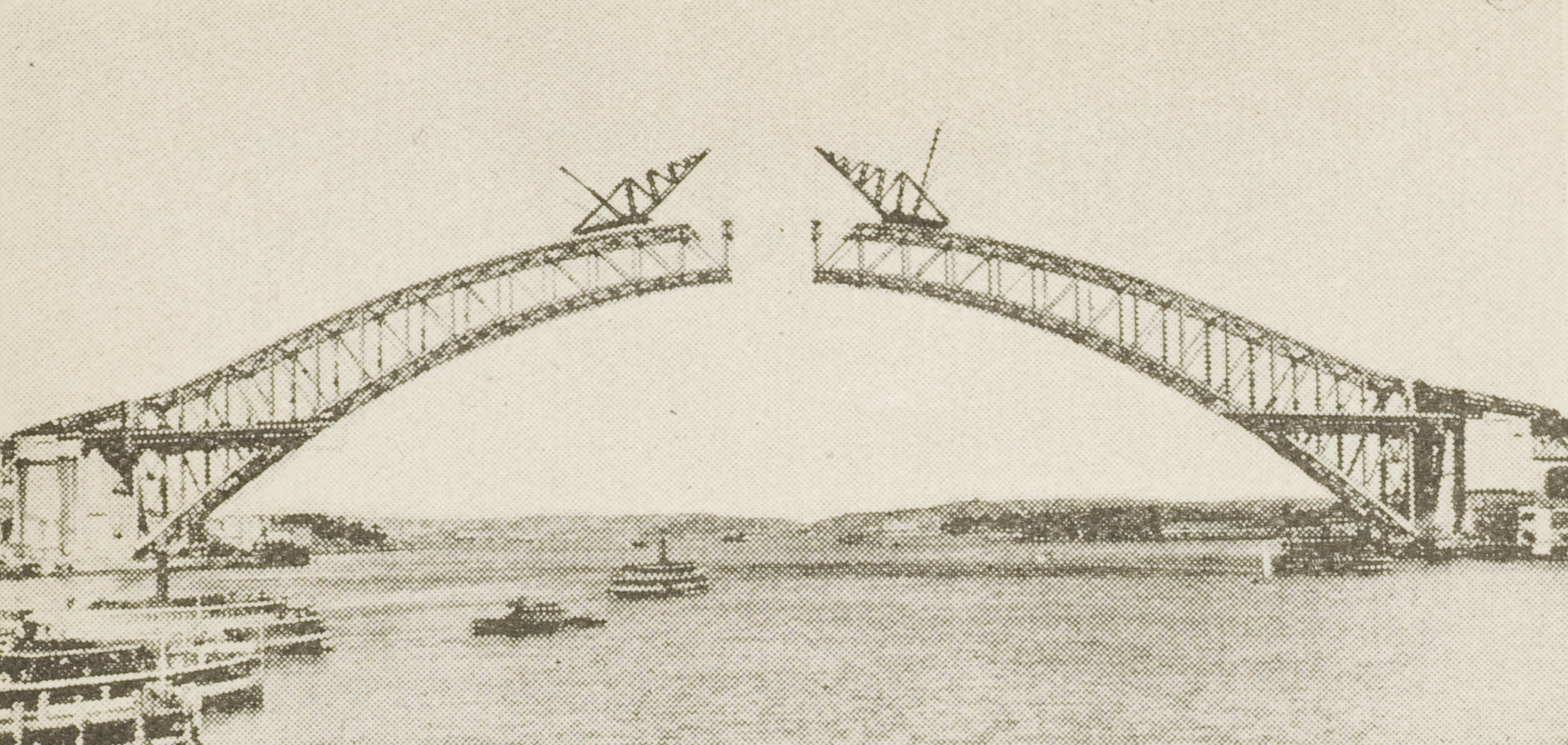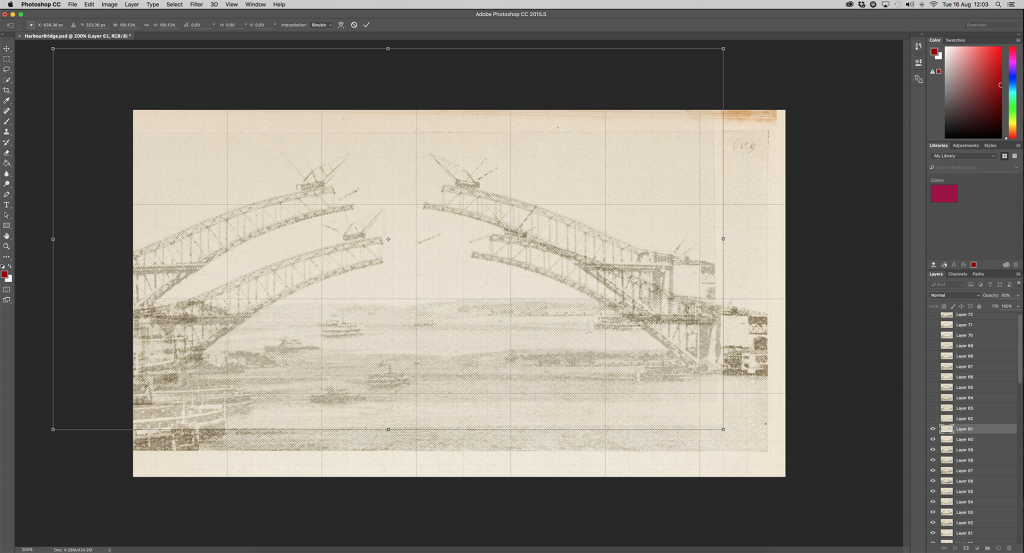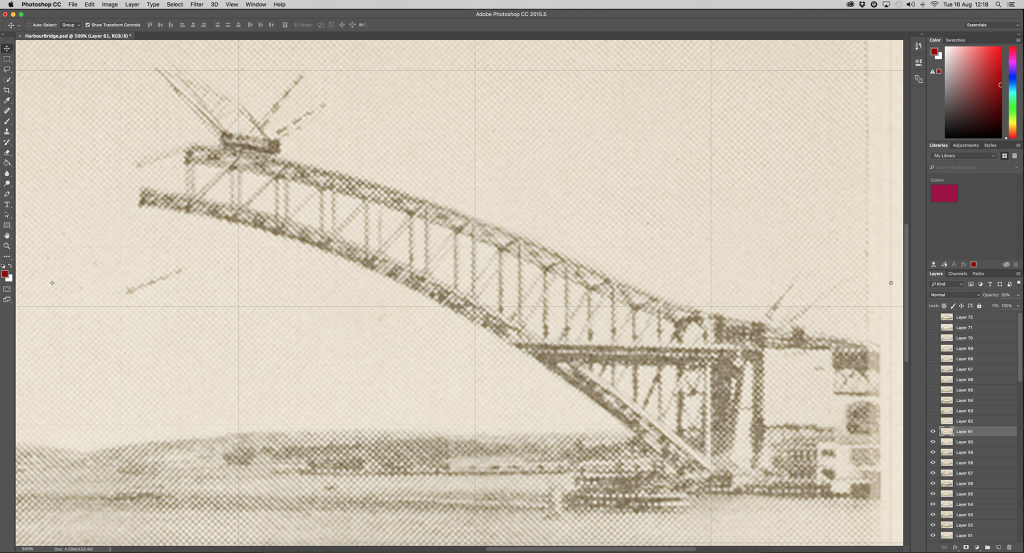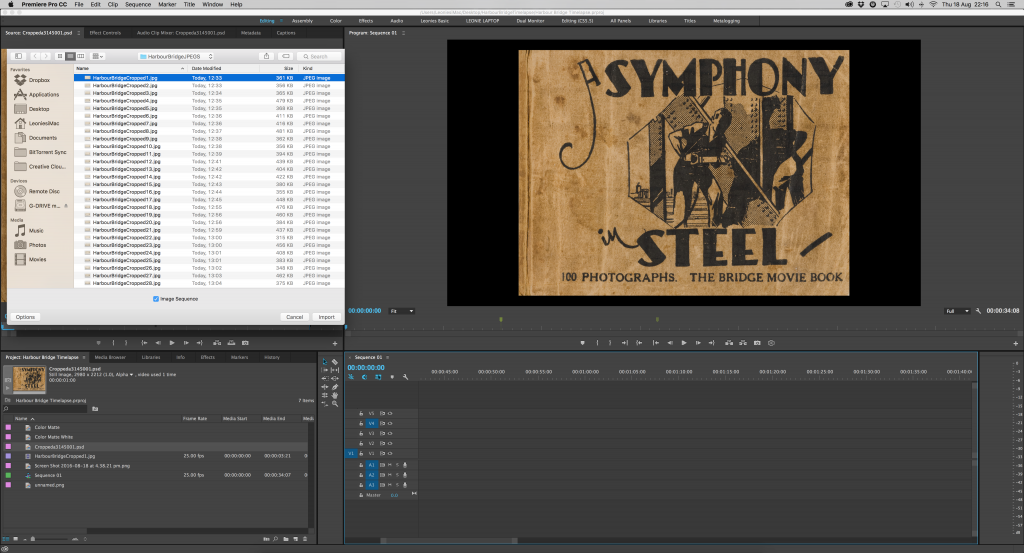
A Symphony in Steel
To celebrate the joining of the span of the Sydney Harbour Bridge on 19th August 1930 we have made a time-lapse of this moment taken from the following item in our collection.
A symphony in steel: 100 photographs of the Sydney Harbour Bridge arranged as a Flickascope. Flick the pages from Back to Front to See it grow…
Posted by Margot Riley, Curator Research and Discovery.
This flickascope (also known as a flip, flick or movie book) is a collection of pictures arranged in a specific order in a small book which was intended to be flipped over by hand (from front to back) to give the illusion of movement creating an animated sequence without the aid of machinery. Souvenirs such as this movie book were produced to coincide with the 1932 completion of the Sydney Harbour Bridge, cashing on the excitement generated by the achievement of such an engineering feat and marking a celebration of progress in the face of adversity during world-wide economic depression.
86 years ago today Sydneysiders woke to a much anticipated sight – the joining of the span of the Sydney Harbour Bridge. After eight years of waiting, and watching, the city breathed a sigh of relief as this modern engineering marvel – the ‘eighth wonder of the world’ – reached a major milestone in its construction. Building of the Sydney Harbour Bridge had started in mid-1923, with erection of the arch beginning on 26 October 1928. During construction, giant ‘creeper cranes’ moved up, and over each side of the arch, lifting men and materials into position to create the steel structure. As the steelwork inched out, over the harbour, seemingly suspended in mid-air, steel cables anchored the upper chords of the arch to prevent its collapse.
On 19 August 1930 the two halves of the arch touched for the first time. At 10pm that night, the top and bottom cords were riveted together and, with the crown of the span finally supporting itself, the cables were removed. The next day, on 20 August 1930, the flags of Australia and the United Kingdom were flown from the jibs of the creeper cranes to celebrate the joining of the arch. As the creeper cranes made their way back down the arches hangers were hoisted into position along the way, supporting the crossbeams which carried the transport deck. By June 1931, the creeper cranes were dismantled, the deck was laid with rails for trains and trams and surfaced for wheeled motor traffic. Finally, the pylons were built at each end of the bridge, and the last piece of granite from Moruya, NSW added on 15 January 1932.
The bridge was officially opened on 19 March 1932, with a massive celebration marking the end of one of largest construction projects ever seen in Australia, made even more remarkable as it had occurred during world-wide economic depression which had hit the nation hard. The Bridge was a symbol of hope for all who saw it – a triumph over adversity – fondly nick-named the ‘coat-hanger’, it is still one of the most recognisable structures in the world today.
Quick Facts:
- 1,400 men worked to build the Sydney Harbour Bridge;
- 128 cables used to support each half-arch;
- 96 steam locomotives used on the Bridge to test its load capacity;
- £4.2 million construction cost not paid off until 1988;
- arch rises 134 metres above the harbour;
- 53 metres’ clearance below its deck to enable ships to pass underneath.
Volume 01: Sydney Harbour Bridge, building the arch 1925-1932 / [compiled by D. J. Fraser, photographs produced by the Government Printer]
Technical stuff by Leonie Jones (Digital Producer)
There were several steps involved in the creation of the time-lapse video of the Harbour Bridge ‘Movie book’. The first step was to open the high-resolution digitised images of each page from the book into Adobe Creative Cloud Photoshop and crop the images to remove any unnecessary space around each photo. I cropped each image to approximately the same dimensions as each other, leaving enough room for later manipulation and cropping.
When the original photos in the book were taken the camera was roughly in the same spot for each shot, but there was naturally some movement over time and throughout the sequence of shots. So, given that the original images were not all exactly aligned the process of lining up each image was quite painstaking. In order to do this, I created a multi-layered Photoshop file (PSD) with all of the cropped images in order from the earliest image at the bottom to the final image as the top layer. I worked from image/layer 1 up, reducing the opacity of each overlapping image to 50% so that I could see the image below and align them one over the other. Once the two images were roughly aligned I then began the process of manipulating the size and tilt of each image so that each corresponding pixel in each image sat exactly over the other. Then it was step and repeat for all 97 images.
Once all of the images were aligned, I then cropped the final PSD to 16:9 screen ratio and exported each individual image out as sequentially numbered JPEGS (screen resolution 72 dpi; HD 1920 x 1080 pixels) for use in the time-lapse video.
I then imported the images into Adobe CC Premiere Pro to create the time-lapse video. I imported the images as an ‘Image sequence’, which told Premiere Pro to treat each image as sequential. This is why it is essential to sequentially number JPEGS in a time-lapse, so that your editing system knows what order to place the images in. Once Premiere had created a video sequence of the images, I was then able to place this sequence on the timeline in my project and adjust the speed/duration of the entire clip to give the best effect.






Comments
Thanks for this awesome article and video.
Thanks for sharing this Peter, it is great to see your version of the time-lapse. What a find you had back in 1967.
Here’s my version. In about 1967, while walking home from school, I noticed a lot of small pieces of paper scattered along the side of the road. On closer inspection, I noticed they showed different stages of the construction of the Harbour Bridge. I spent ages trying to find every piece there was, in amongst the long grass and weeds. In my uncommon wisdom, I glued them into an exercise book. If I hadn’t done this, I certainly wouldn’t still have them. I have scanned and aligned them to create this “timelapse”. https://www.youtube.com/watch?v=7eX0Bb_nAbw